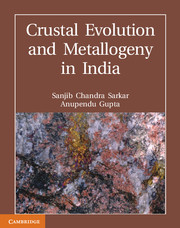Book contents
- Frontmatter
- Dedication
- Contents
- List of Figures
- List of Tables
- List of Plates
- Preface
- Chapter 1 Southern India
- Chapter 2 Central India
- Chapter 3 Eastern Ghat Belt
- Chapter 4 Eastern India
- Chapter 5 North-East India
- Chapter 6 Western India
- Chapter 7 The Himalaya
- Chapter 8 Crustal Evolution and Metallogeny in India: A Brief Review in the Context of the World Scenario
- References
- Index
- Plate Section
Chapter 1 - Southern India
Published online by Cambridge University Press: 05 February 2014
- Frontmatter
- Dedication
- Contents
- List of Figures
- List of Tables
- List of Plates
- Preface
- Chapter 1 Southern India
- Chapter 2 Central India
- Chapter 3 Eastern Ghat Belt
- Chapter 4 Eastern India
- Chapter 5 North-East India
- Chapter 6 Western India
- Chapter 7 The Himalaya
- Chapter 8 Crustal Evolution and Metallogeny in India: A Brief Review in the Context of the World Scenario
- References
- Index
- Plate Section
Summary
Geology and Crustal Evolution
Introduction
Southern Indian craton today is divided into two regions: the Dharwar Province (DP) and the Southern Granulite Province (SGP) or Southern Granulite Terrain (SGT) (Fig. 1.1.1). The Dharwar Province, ever since the publication of results of excellent geological studies by the geologists of the erstwhile Mysore Geological Survey during the first half of the last century, has remained an area of great interest for Indian earth-scientists. In the last decades, it has drawn the attention of a number of foreign scientists too. The Dharwar Province is characterised by the same trinity that characterises most other Archean terrains in the world (Fig. 1.1.2). It comprises the following:
A middle Archean tonalite-trondhjemite-granodiorite (TTG)-dominant basement (‘Peninsular Gneiss’),
Two generations of Archean green stone belts (‘schist belts’ in local geological literature since the time of their earliest description), represented by the older Sargur Group and the younger Dharwar Supergroup rocks,
Late Archean granitoids with/without a mantle affiliation.
Radhakrishna and Vaidyanathan (1994) suggested that the generalised term ‘Peninsular Gneiss’ coined by Smeeth about a century ago (Smeeth, 1915) be abandoned and instead, ‘older gneiss’, be used for those older than 3.0 Ga and ‘younger gneissic complex’ for those formed at ∼ 2.6 Ga. Chadwick et al. (1997) would, however, prefer retention of the term for the gneisses dated > 3.0 Ga. The opinion of Radhakrishna and Vaidyanathan has a valid logic.
- Type
- Chapter
- Information
- Crustal Evolution and Metallogeny in India , pp. 1 - 152Publisher: Cambridge University PressPrint publication year: 2012



